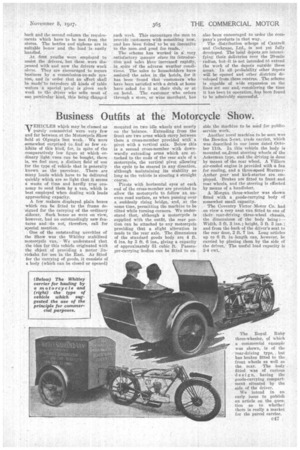Business Outfits at the Motorcycle Show.
Page 105

If you've noticed an error in this article please click here to report it so we can fix it.
VEHICLES tyl4ch may be classed as V purely -commercial were very few and far between at the Motorcycle Show held at Olympia last week. • We were somewhat surprised to. find so few exhibits of this kind, for, in spite of the comparatively low figure at which ordinary light vans can bebought, there is, we feel sure, a distinct field of .use for the type of vehicle that is generally known as the parcelcar. There are many Loads which have to be delivered quickly which are so light that it seems a waste of time and hardly true economy to send them by a van, which is best employed when dealing with loads approaching capacity.
A few makers displayed plain boxes which can be fitted to the frame designed for the carrying of the ordinary sidecar. Such boxes as -were on view, however, had no .outstandingly new features and do not, therefore, call for 'special mention.
One of the outstanding novelties of the Show was the Whitley stabilised motorcycle van. We understand that the idea for this vehicle originated with the •Object of providing a motor jinricksha for use in the BastAs fitted for the carrying of goods, it consists of a body (which can be closed or opened)
mounted on two idle wheels and nearly on the balance. Extending from the front are two arms which carry between them a cross-member provided with a pivot with a vertical axis. Below this is a second cross-member with downwardly extending arms which are attached to the ends of the rear axle of a' Motorcycle, the vertical pivot allowing the cycle to be steered in any direction, although maintaining its stability so long as the vehicle is steering Straight course.
Pivots with horizontal eyes at each end of the cross-member are provided to allow the motorcycle to follow an uneven road surface, as when passing over a suddenly rising bridge, and, at the same time, permitting the machine to be tilted while turning corners. We understand that, although a motorcycle is suppliedwith the outfit, the rear portion can be attached to any motorcycle providing that a slight alteration is made to the rear axle. The dimensions of the standard goods body are 4 ft. 6 ins. by 3 ft. 6 ins., giving a capacity of approximately 51 cubic ft. • Passenger-carrying bodies can be fitted to en
able the machine to be used for publicservice work.
Another, novel machine to be seen was the Bowden 5-cwt. trade carrier, which was described in our issue dated October 11th. In this vehicle the body is mounted on.front steering wheels of the Ackerman type, and the driving is done by means of the rear wheel. A Villiers air-cooled engine is provided with a fan for cooling, and a three-speed SturmeyArcher gear and kick.-starter are employed. Brakes are fitted to front and Tear wheels, and the steering is effected by means of a handlebar.
A Morgan three-wheeler was ehown fitted with a goods-carrying body of somewhat small capacity. •
The Coventry Victor Motor Co. had on view a very neat van fitted to one of their rear-driving three-wheel chassis, the dimensions of the body being:— Width, 3 ft. 3 ins.; height, 3 ft. 3 ins. ;. and from the back -of the driver's seat to the rear door, 2 ft. 7 ins. Long articles up to 6 ft.. in length can,. however, be carried by placing them by the side cif the driver. The useful load capacity is 3-4 cwt.




















































































































































































